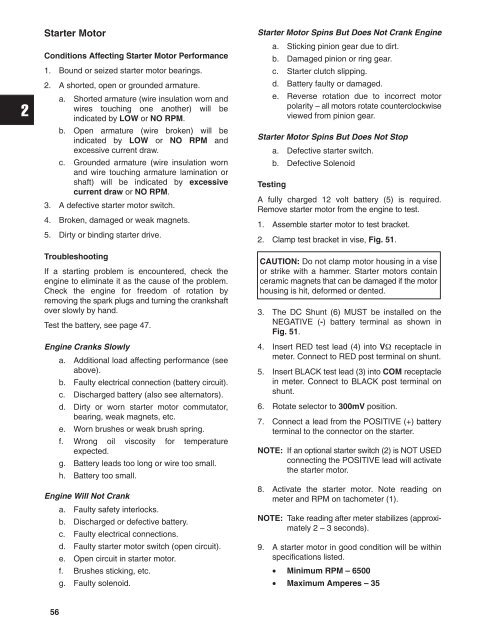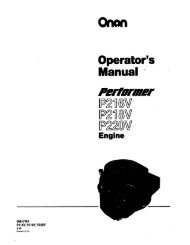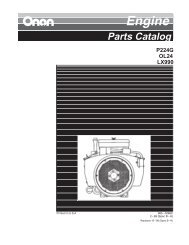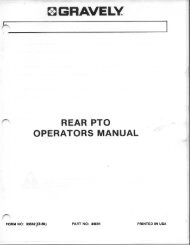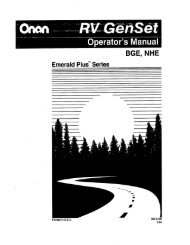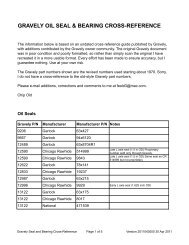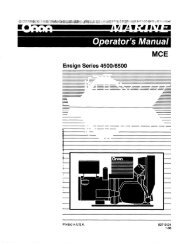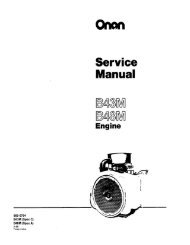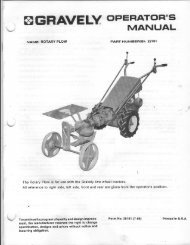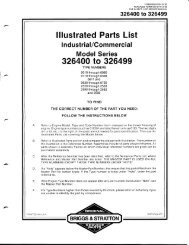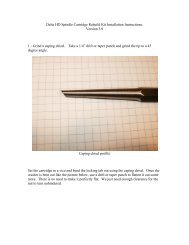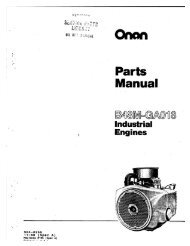272144 Vanguard Twin Cylinder OHV BRIGGS & STRATTON.pdf
272144 Vanguard Twin Cylinder OHV BRIGGS & STRATTON.pdf
272144 Vanguard Twin Cylinder OHV BRIGGS & STRATTON.pdf
You also want an ePaper? Increase the reach of your titles
YUMPU automatically turns print PDFs into web optimized ePapers that Google loves.
Starter Motor<br />
Conditions Affecting Starter Motor Performance<br />
1. Bound or seized starter motor bearings.<br />
2. A shorted, open or grounded armature.<br />
a. Shorted armature (wire insulation worn and<br />
wires touching one another) will be<br />
indicated by LOW or NO RPM.<br />
b. Open armature (wire broken) will be<br />
indicated by LOW or NO RPM and<br />
excessive current draw.<br />
c. Grounded armature (wire insulation worn<br />
and wire touching armature lamination or<br />
shaft) will be indicated by excessive<br />
current draw or NO RPM.<br />
3. A defective starter motor switch.<br />
4. Broken, damaged or weak magnets.<br />
5. Dirty or binding starter drive.<br />
Troubleshooting<br />
If a starting problem is encountered, check the<br />
engine to eliminate it as the cause of the problem.<br />
Check the engine for freedom of rotation by<br />
removing the spark plugs and turning the crankshaft<br />
over slowly by hand.<br />
Test the battery, see page 47.<br />
Engine Cranks Slowly<br />
a. Additional load affecting performance (see<br />
above).<br />
b. Faulty electrical connection (battery circuit).<br />
c. Discharged battery (also see alternators).<br />
d. Dirty or worn starter motor commutator,<br />
bearing, weak magnets, etc.<br />
e. Worn brushes or weak brush spring.<br />
f. Wrong oil viscosity for temperature<br />
expected.<br />
g. Battery leads too long or wire too small.<br />
h. Battery too small.<br />
Engine Will Not Crank<br />
a. Faulty safety interlocks.<br />
b. Discharged or defective battery.<br />
c. Faulty electrical connections.<br />
d. Faulty starter motor switch (open circuit).<br />
e. Open circuit in starter motor.<br />
f. Brushes sticking, etc.<br />
g. Faulty solenoid.<br />
Starter Motor Spins But Does Not Crank Engine<br />
a. Sticking pinion gear due to dirt.<br />
b. Damaged pinion or ring gear.<br />
c. Starter clutch slipping.<br />
d. Battery faulty or damaged.<br />
e. Reverse rotation due to incorrect motor<br />
polarity – all motors rotate counterclockwise<br />
viewed from pinion gear.<br />
Starter Motor Spins But Does Not Stop<br />
a. Defective starter switch.<br />
b. Defective Solenoid<br />
Testing<br />
A fully charged 12 volt battery (5) is required.<br />
Remove starter motor from the engine to test.<br />
1. Assemble starter motor to test bracket.<br />
2. Clamp test bracket in vise, Fig. 51.<br />
CAUTION: Do not clamp motor housing in a vise<br />
or strike with a hammer. Starter motors contain<br />
ceramic magnets that can be damaged if the motor<br />
housing is hit, deformed or dented.<br />
3. The DC Shunt (6) MUST be installed on the<br />
NEGATIVE (-) battery terminal as shown in<br />
Fig. 51.<br />
4. Insert RED test lead (4) into V receptacle in<br />
meter. Connect to RED post terminal on shunt.<br />
5. Insert BLACK test lead (3) into COM receptacle<br />
in meter. Connect to BLACK post terminal on<br />
shunt.<br />
6. Rotate selector to 300mV position.<br />
7. Connect a lead from the POSITIVE (+) battery<br />
terminal to the connector on the starter.<br />
NOTE: If an optional starter switch (2) is NOT USED<br />
connecting the POSITIVE lead will activate<br />
the starter motor.<br />
8. Activate the starter motor. Note reading on<br />
meter and RPM on tachometer (1).<br />
NOTE: Take reading after meter stabilizes (approximately<br />
2 – 3 seconds).<br />
9. A starter motor in good condition will be within<br />
specifications listed.<br />
• Minimum RPM – 6500<br />
• Maximum Amperes – 35<br />
56


